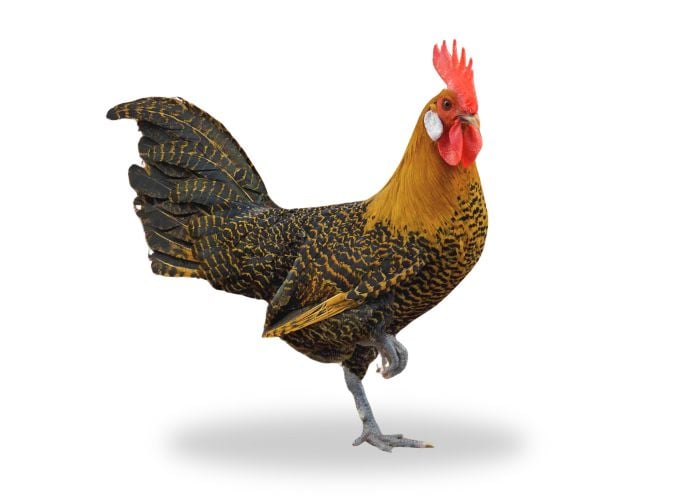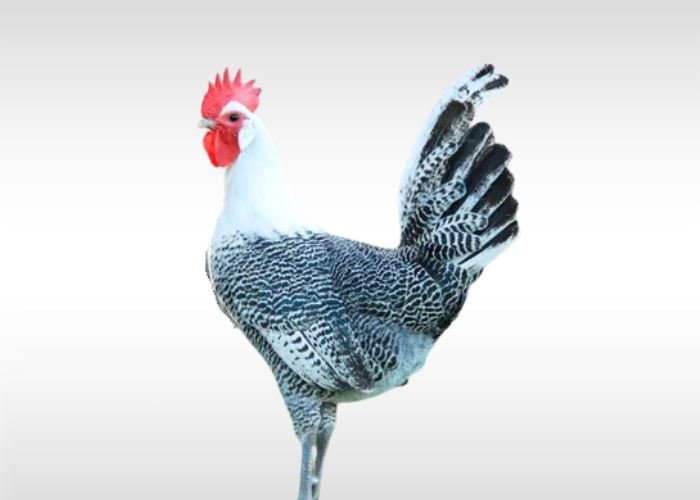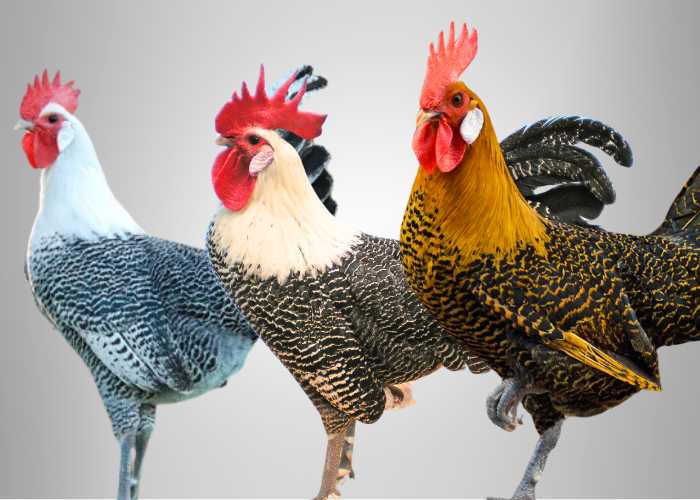Have you ever seen a chicken that looks like it walked out of a storybook?
The Campine chicken breed is just that kind of bird.
With shiny feathers, a curious personality, and lots of energy, Campines are fun to watch and even more fun to raise.
These chickens are known for being great egg-layers and for their striking good looks.
In this article, we’ll learn everything about the Campine chicken breed, from where it came from to how to take care of it in your own backyard.
Campine Chicken Breed: A Quick Overview
| Campine Chicken Breed Overview | |
| Height | 14 to 18 inches |
| Weight | Rooster: ~6 lbs, Hen: ~4 lbs |
| Comb | Single, upright comb |
| Varieties | Silver Campine, Golden Campine |
| Eggs per year | Approximately 150–200 white eggs |
| Personality | Active, curious, independent, alert |

History of the Campine Chicken Breed
The Campine chicken breed comes from Belgium.
It’s named after a region called “Campine” in northern Belgium, where it was first raised many years ago.
Farmers there wanted a chicken that was good at laying eggs and could handle colder weather.
Over time, they bred chickens that were not only tough but also beautiful.
The breed became popular in England in the 1800s and then traveled to other parts of the world, including the United States.
Today, it’s a rare but much-loved breed among backyard chicken keepers.
Campine Chickens: Appearance
Campine chickens are small to medium in size, but don’t let that fool you. They have big personalities!
Their feathers are tight and shiny, and they come in two main colors:
Varieties
Silver Campine
White head with silver and black feathers on the body
Golden Campine
Golden head with golden and black feathers
Other Features
- Upright posture
- Clean legs (no feathers)
- Bright red comb and wattles
- White earlobes
Additionally, their feathers are laced with dark edges, giving them a fancy look.
Campine Chicken Breed: Personality
The Campine chicken breed is known for being:
- Active: They love to run, explore, and forage.
- Smart: These birds are quick learners and know their way around.
- Independent: They can take care of themselves pretty well.
- Friendly: While not lap chickens, they often get along well with people.
Campines are always on the move.
If you want a calm chicken that sits still, the Campine might not be the one.
But if you want an active bird with a lot of charm, Campines are perfect!
Looking for calmer breeds? CHECK THIS OUT: Docile Chicken Breeds
How Many Eggs Do Campine Chickens Lay?
Even though the Campine chicken breed is small, it lays a surprising number of eggs. You can expect:
- 150–200 white eggs per year
- Medium-sized eggs
- Good winter laying ability
Campines usually start laying around 5 to 6 months of age.
They don’t go broody often, so they don’t stop laying eggs to sit on them like other hens do.
WINTER TIP: Keep Hens Laying Eggs Through The Winter

How to Take Care of Campine Chickens
Caring for the Campine chicken breed is similar to caring for most other chickens, but here are some tips to help:
Housing Tips
- Give them space to roam (Campines love to explore!)
- Use strong fencing, as they are good flyers.
- Keep the coop dry and well-ventilated.
ALSO READ: Top 10 Best DIY Chicken Coop Designs for Your Flock in 2025
Feeding Tips
- Provide a balanced chicken feed.
- Offer treats like fruits, grains, and vegetables.
- Always have fresh water available.
ALSO READ: 9 Healthy Treats Your Chickens Will Love
Health Tips
- Keep the coop clean to prevent illness.
- Watch for mites or lice (Campines’ feathers can hide pests).
- Vaccinate if needed and check their health regularly.
ALSO READ: Chicken Vaccination: What You Need to Know
Is the Campine Chicken Breed Right for You?
Before choosing the Campine chicken breed, ask yourself:
- Do I want an active, fun-to-watch bird?
- Do I have enough space for chickens to roam?
- Am I okay with a chicken that might not love being held?
If the answer is yes, then Campines might be a great fit for you and your family.
They’re especially great for families with kids who enjoy watching animals play and explore.
Interested in more family-friendly breeds? You might want to check this complete list of the Best Chicken Breeds for Families & Kids!

Why Is the Campine Chicken Breed Rare?
The Campine chicken breed is considered rare today. That’s because:
First, bigger breeds with more meat or higher egg production became more popular.
Second, some people found Campines too active for small spaces.
Because they are rare, raising Campines helps keep the breed alive.
In fact, they are already tagged as “Threatened” in the Conservation Priority List from The Livestock Conservancy.
This means the Campine chicken breed is one step closer to being endangered.
If you choose this breed, you’re helping to protect an old and special type of chicken.
If you’re into rare and exotic chicken breeds, check out this video:
Frequently Asked Questions About the Campine Chickens
Q: Do Campine chickens get along with other breeds?
A: Yes, they usually do. But since they are active, they might annoy calmer chickens.
Q: Are Campines noisy?
A: They aren’t the loudest chickens, but talkative, especially when excited.
Q: Can Campine chickens handle cold weather?
A: They were bred in Belgium and can do well in cold climates.
Q: Are they good for beginners?
A: Yes, but beginners should know they are not cuddly birds. Again, they prefer space to move around.
Q: How long do Campine chickens live?
A: With good care, they can live 7 to 10 years.
Campine Chicken Breed: Before You Go…
The Campine chicken breed is a small, beautiful, and lively bird with a lot of charm.
It may not be the most common breed, but it is a favorite among those who love rare and unique chickens.
With their pretty feathers, curious personalities, and reliable egg-laying, Campines make a great addition to any backyard flock.
If you want a fun, active, and special chicken, the Campine breed might be right for you.
